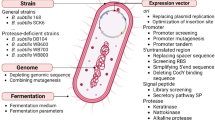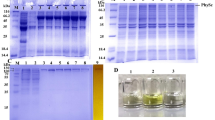Abstract
Electrostatic interactions are important in protein folding, binding, flexibility, stability and function. The pH at which the enzyme is maximally active is determined by the pKas of the active site residues, which are modulated by several factors including the change in electrostatics in its vicinity. As the acidic xylanases are important in food and animal feed industries, electrostatic interactions are introduced in Bacillus circulans xylanase to shift their pH optima towards the acidic side. Arg substitutions are made to modulate the pKas of the active site residues. Neutral residues are substituted by Arg in such a way that the substituted residue can make direct interaction with the catalytic residues. However, the mutations with other titratable residues (Asp, Arg, Lys, His, Tyr, and Ser) present in between the catalytic sites and the substituted sites are avoided. Site directed mutagenesis was conducted to confirm the strategy. The results show the shift in pH optima of the mutants towards the acidic side by 0.5–1.5 unit. Molecular dynamics simulation of the mutant V37R reveals that the decrease in activity is due to the increase in distance between the substrate oxygen atoms and catalytic glutamates.
Similar content being viewed by others
References
Dominguez, R., H. Souchon, S. Spinelli, Z. Dauter, K. S. Wilson, S. Chauvaux, P. Beguin, and P. M. Alzari (1995) A common protein fold and similar active site in two distinct families of β-glycanases. Nature Structural Biol. 2: 569–576.
Henrissat, B. and A. Bairoch (1993) New families in the classification of glycosyl hydrolases based on amino acid sequence similarities. Biochem. J. 293: 781–788.
Törrönen, A. and J. Rouvinen (1997) Structural and functional properties of low molecular weight endo-1,4-β-xylanases. J. Biotechnol. 57: 137–149.
Törrönen, A. (1995) Structural comparison of two major endo-1,4-xylanases from trichoderma reesei. Biochem. 34: 847–856.
Polizeli, M. L. T. M., A. C. S. Rizzatti, R. Monti, H. F. Terenzi, J. A. Jorge, and D. S. Amorim (2005) Xylanases from fungi: Properties and industrial applications. Appl. Microbiol. Biotechnol. 67: 577–591.
Joo, J. C., S. P. Pack, Y. H. Kim, and Y. J. Yoo (2011) Thermostabilization of Bacillus circulans xylanase: Computational optimization of unstable residues based on thermal fluctuation analysis. J. Biotechnol. 151: 56–65.
Joo, J. C., S. Pohkrel, S. P. Pack, and Y. J. Yoo (2010) Thermostabilization of Bacillus circulans xylanase via computational design of a flexible surface cavity. J. Biotechnol. 146: 31–39.
Beg, Q. K., M. Kapoor, L. Mahajan, and G. S. Hoondal (2001) Microbial xylanases and their industrial applications: A review. Appl. Microbiol. Biotechnol. 56: 326–338.
Tan, S. S., D. Y. Li, Z. Q. Jiang, Y. P. Zhu, B. Shi, and L. T. Li (2008) Production of xylobiose from the autohydrolysis explosion liquor of corncob using Thermotoga maritima xylanase B (XynB) immobilized on nickel-chelated Eupergit C. Bioresour. Technol. 99: 200–204.
Tenkanen, M., L. Viikari, and J. Buchert (1997) Use of acid-tolerant xylanase for bleaching of kraft pulps. Biotechnol. Techniques. 11: 935–938.
Inoue, M., H. Yamada, T. Yasukochi, R. Kuroki, T. Miki, T. Horiuchi, and T. Imoto (1992) Multiple role of hydrophobicity of tryptophan-108 in chicken lysozyme: Structural stability, saccharide binding ability, and abnormal pKa of glutamic acid-35. Biochem. 31: 5545–5553.
Viikari, L., A. Kantelinen, J. Sundquist, and M. Linko (1994) Xylanases in bleaching: From an idea to the industry. FEMS Microbiol. Rev. 13: 335–350.
Chinea, G., G. Padron, R. W. W. Hooft, C. Sander, and G. Vriend (1995) The use of position-specific rotamers in model building by homology. Proteins: Structure, Function and Gen. 23: 415–421.
Pettersen, E. F., T. D. Goddard, C. C. Huang, G. S. Couch, D. M. Greenblatt, E. C. Meng, and T. E. Ferrin (2004) UCSF Chimera — A visualization system for exploratory research and analysis. J. Computat. Chem. 25: 1605–1612.
Dolinsky, T. J., J. E. Nielsen, J. A. McCammon, and N. A. Baker (2004) PDB2PQR: An automated pipeline for the setup of Poisson-Boltzmann electrostatics calculations. Nucleic Acids Res. 32: 665–667.
Joshi, M. D., G. Sidhu, J. E. Nielsen, G. D. Brayer, S. G. Withers, and L. P. McIntosh (2001) Dissecting the electrostatic interactions and pH-dependent activity of a family 11 glycosidase. Biochem. 40: 10115–10139.
Joshi, M. D., G. Sidhu, I. Pot, G. D. Brayer, S. G. Withers, and L. P. McIntosh (2000) Hydrogen bonding and catalysis: A novel explanation for how a single amino acid substitution can change the pH optimum of a glycosidase. J. Mol. Biol. 299: 255–279.
Zheng, L., U. Baumann, and J. L. Reymond (2004) An efficient one-step site-directed and site-saturation mutagenesis protocol. Nucleic Acids Res. 32. 115.
Li, Z. L., T. M. Bricker, and R. Burnap (2000) Kinetic characterization of His-tagged CP47 Photosystem II in Synechocystis sp. PCC6803. Biochim. Biophysic. Acta — Bioenerg. 1460: 384–389.
Laemmli, U. K. (1970) Cleavage of structural proteins during the assembly of the head of bacteriophage T4. Nature 227: 680–685.
Miller, G. L. (1959) Use of dinitrosalicylic acid reagent for determination of reducing sugar. Anal. Chem. 31: 426–428.
Vandermarliere, E., T. M. Bourgois, S. Rombouts, S. Van Campenhout, G. Volckaert, S. V. Strelkov, J. A. Delcour, A. Rabijns, and C. M. Courtin (2008) Crystallographic analysis shows substrate binding at the −3 to +1 active-site subsites and at the surface of glycoside hydrolase family 11 endo-1,4-β-xylanases. Biochem. J. 410: 71–79.
Vardakou, M., C. Dumon, J. W. Murray, P. Christakopoulos, D. P. Weiner, N. Juge, R. J. Lewis, H. J. Gilbert, and J. E. Flint (2008) Understanding the structural basis for substrate and inhibitor recognition in eukaryotic GH11 xylanases. J. Mol. Biol. 375: 1293–1305.
Davies, M. N., C. P. Toseland, D. S. Moss, and D. R. Flower (2006) Benchmarking pKa prediction. BMC Biochem. 7: 18.
Masui, A., N. Fujiwara, K. Yamamoto, M. Takagi, and T. Imanaka (1998) Rational design for stabilization and optimum pH shift of serine protease aprN. J. Ferment. Bioeng. 85: 30–36.
Masui, A., N. Fujiwara, and T. Imanaka (1994) Stabilization and rational design of serine protease AprM under highly alkaline and high-temperature conditions. Appl. Environ. Microbiol. 60: 3579–3584.
Shirai, T., A. Suzuki, T. Yamane, T. Ashida, T. Kobayashi, J. Hitomi, and S. Ito (1997) High-resolution crystal structure of M-protease: Phylogeny aided analysis of the high-alkaline adaptation mechanism. Prot. Eng. 10: 627–634.
Turunen, O., M. Vuorio, F. Fenel, and M. Leisola (2002) Engineering of multiple arginines into the Ser/Thr surface of Trichoderma reesei endo-1,4-β-xylanase II increases the thermotolerance and shifts the pH optimum towards alkaline pH. Prot. Eng. 15: 141–145.
Russell, A. J. and A. R. Fersht (1987) Rational modification of enzyme catalysis by engineering surface charge. Nature 328: 496–500.
Tynan-Connolly, B. M. and J. E. Nielsen (2007) Redesigning protein pKa values. Prot. Sci. 16: 239–249.
Tina, K. G., R. Bhadra, and N. Srinivasan (2007) PIC: Protein Interactions Calculator. Nucleic Acids Res. 35: 473–476.
Kamal, M. Z., T. A. S. Mohammad, G. Krishnamoorthy, and N. M. Rao (2012) Role of active site rigidity in activity: Md simulation and fluorescence study on a lipase mutant. PLoS ONE. 7.
Author information
Authors and Affiliations
Corresponding author
Rights and permissions
About this article
Cite this article
Pokhrel, S., Joo, J.C. & Yoo, Y.J. Shifting the optimum pH of Bacillus circulans xylanase towards acidic side by introducing arginine. Biotechnol Bioproc E 18, 35–42 (2013). https://doi.org/10.1007/s12257-012-0455-x
Received:
Revised:
Accepted:
Published:
Issue Date:
DOI: https://doi.org/10.1007/s12257-012-0455-x




